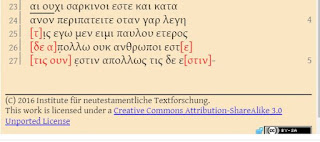I could use some help.
Here is minuscule 1424 at 1 Pet 4:11, located on the CSNTM website as GA_1424_0213b.jpg. [I haven’t found a way to navigate the CSNTM without wanting to end my life, but the image is roughly 60% down, two pages before 2Pt]
My gripe is with the reading ης χορηγει.
It seems to me that the first letter of ης is the result of a correction, mostly because of its dark ink, but also because of the majuscule η that is used. The circumflex above is part of the correction, but the breathing seems original.
Which leads me to assume, if correct, that we had here originally ὡς, just as in the line above, after the comma. The omega would fit under the current eta.
Am I seeing things that are not there? And, in light of the discussion earlier in the week is this a 1424*vid, or is this all too speculative?
Here is minuscule 1424 at 1 Pet 4:11, located on the CSNTM website as GA_1424_0213b.jpg. [I haven’t found a way to navigate the CSNTM without wanting to end my life, but the image is roughly 60% down, two pages before 2Pt]
My gripe is with the reading ης χορηγει.
It seems to me that the first letter of ης is the result of a correction, mostly because of its dark ink, but also because of the majuscule η that is used. The circumflex above is part of the correction, but the breathing seems original.
Which leads me to assume, if correct, that we had here originally ὡς, just as in the line above, after the comma. The omega would fit under the current eta.
Am I seeing things that are not there? And, in light of the discussion earlier in the week is this a 1424*vid, or is this all too speculative?














